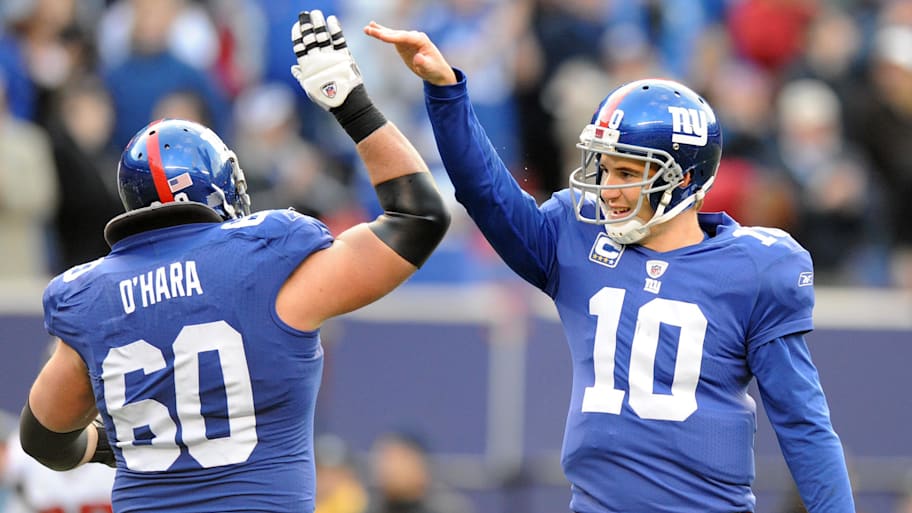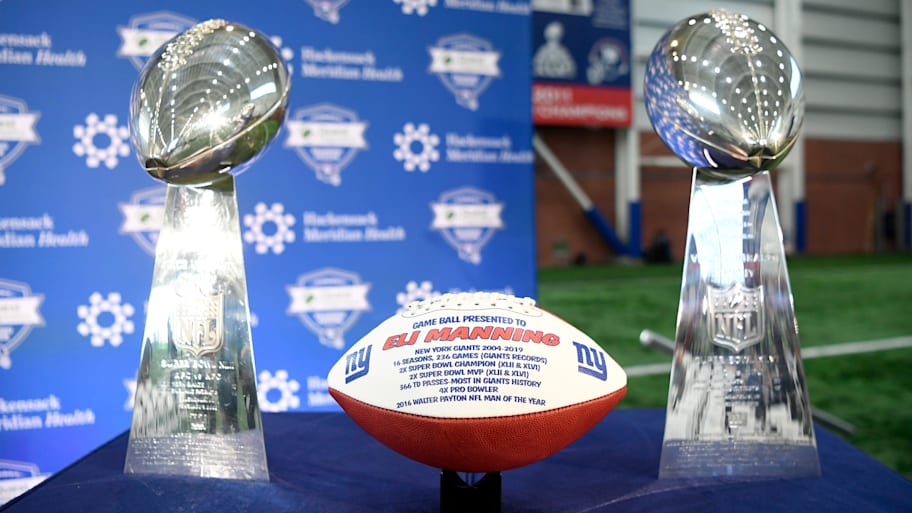
The countdown to the start of the New York Giants’ 2025 season is underway, as we’re now 10 days away from the opening kickoff against the Washington Commanders. To count down the days until then, we look at the best players to wear the corresponding number for the Giants.
Who Wore No. 10 in at Least One Regular Season Game*
G/T Swede Nordstrom (1925), T Ed McGinley (1925), OL Doc Alexander (1926), Back/End Chuck Corgan (1927), T Corrie Artman (1931), G Potsy Jones (1932-36), QB Mickey Kobrosky (1937), Back Len Barnum (1938-40), T/C Lou DeFilippo (1945), FB Howie Livingston (1946-47), QB Henry Schichtle (1964), QB Fran Tarkenton (1967-71), LB Brad Van Pelt (1973-83), WR Beau Almodobar (1987), QB Kent Graham (1992-99), P Tom Rouen (2002), P Jeff Feagles (2003), QB Eli Manning (2004-19)
*Jersey numbers according to Pro Football Reference.
Which Giants Player Wore It Best?

When going down the list of jersey numbers when we started this series a couple of months ago, the No.10 was one of those digits you could circle immediately and need no room for research if you've grown up a modern-day observer of the New York Giants and the infamous quarterback who made it legendary.
That, of course, was quarterback Eli Manning, the Giants' 2004 first-round pick out of Ole Miss, who would cement himself as a special player in the NFL from before he even stepped onto the podium to shake the hand of then commissioner Paul Tagliabue with his new blue hat sitting snug on his head.
As the unforgettable story goes, Manning was slated to go No. 1 overall to the then San Diego Chargers as the top quarterback prospect in that year's class.
However, Manning and his family weren't sold on playing for the team on the West Coast, pushing the Chargers to execute a once-in-a-generation draft day trade with the Giants, who sat three spots beneath them at No. 4.
The deal, which is still discussed during the draft today, saw the Giants select Phillip Rivers with their fourth overall selection and send him to San Diego in exchange for Manning, along with a third-round pick, a first-round pick the following year, and a fifth-round selection from the same 2005 draft.
While Manning was in a class that would bear several accomplished quarterbacks, including Rivers and Pittsburgh Steelers great Ben Roethlisberger, none would go on to scratch the same level of a resume that Manning would in his decade and a half reign in the Giants' offensive huddle.
Manning's rookie season didn't give off the appearance of a player who would become a franchise signal caller in the making, especially as he was thrust into the middle of the first game of the season in relief of starter Kurt Warner in the fourth quarter.
He would go 3-of-9 for 66 yards in his debut, leaving an early bad taste in the mouths of the fanbase who expected more from the novice.
The rest of his first campaign, Manning would appear in nine games for the Giants, completing only 48.2% of his throws for 1,043 yards, six touchdowns, and nine interceptions, while getting sacked 13 times during that span.
The Giants would finish the year with a 6-10 record, and Warner would leave the franchise that offseason, putting his successor's career in the driver's seat from that point.
This is when Manning would start to deliver those results that many were waiting to see from a player whose family was becoming a household name in the football world. In 2005, Manning would boost his stats up to a 52.8% completion rating in a Giants' offense that ranked in the top five in the league, posting 3,762 yards, 24 touchdowns, and 17 interceptions to carry them back into the postseason.
Each season, Manning improved progressively as a passer, particularly in his ability to remain calm and poised in the pocket, delivering huge throws in the biggest moments of games. The first taste of that came in the 2007 season, when he guided the Giants on an epic playoff run to Super Bowl XLII against the New England Patriots.
With the Giants trailing the Patriots 14-10 with 2:42 remaining in the championship bout, Manning led the team 83 yards downfield and was almost stopped short of the finish line at the Giants' 44-yard line by New England's elite defense.
That was until, on third down-and-5, Manning dodged a couple of near sacks and launched a pass through the skies of Arizona to receiver David Tyree, who completed the infamous helmet catch and set up the game-winning score by Plaxico Burress.
In an unbelievable upset, Manning and company would defeat the Patriots, who would fall one game shy of achieving the second perfect season in NFL history, after the 1972 Miami Dolphins.
Four years later, the Giants would do it again behind the quarterback heroics of Manning, who capped off a third Pro Bowl-caliber season with nearly 5,000 passing yards, 29 touchdowns, and another elite postseason run that ended in defeating the Patriots 21-17 in Super Bowl XLVI.
Following that second title, the remainder of Manning's tenure, albeit solidified as legendary, would experience a downturn as the Giants would finish six of his last eight seasons with a losing record and an average to mediocre offensive system.
The team would attempt to surround their aging arm with talented young weapons to return to the pinnacle one more time. Still, it would largely go fruitless, with only one additional postseason appearance in the 2016 season.
The two sides would even experience a bad decision in the midst of a 2-9 start to the 2017 season, when head coach Ben McAdoo elected to bench the two-time Super Bowl MVP and go with backup Geno Smith as the starter for the next game against the Raiders.
The move would ultimately backfire for McAdoo, later costing him his job and prematurely ending Manning's streak of 210 consecutive regular-season starts, which ranked second all-time.
In his final two seasons with the team, Manning would appear in 20 games, notching one last 4,000+ yard stat sheet in 2018 with 27 combined touchdowns and 16 interceptions. The Giants would go on to draft quarterback Daniel Jones at No. 6 in the 2019 draft, and the rookie would slowly phase Manning out of the starting role.
None of those end-of-the-road misfortunes would take anything away from the remarkable and durable resume Manning had built as a true lifetime Giant. At the end of his 16 years as a pro, he held 236 games of service with a 60.3% career completion percentage for 57,023 yards, 336 touchdowns, and 224 interceptions.
Manning’s passing lines include 14 consecutive seasons with over 3,000 passing yards and seven years over the 4,000-yard mark, with his career-high 4,933 in the 2011 Super Bowl season. He still holds eight of the top 10 best single-season passing yards records by the Giants, including the top four dating back to 2011.
Along with his two rings, Manning was a two-time Super Bowl MVP, a four-time Pro Bowler (2008, 2011, 2012, 2015), a Walter Payton Man of the Year award winner (2016), and a winner of the Bart Starr award for outstanding leadership at the end of the 2020 season.
Manning still holds the NFL records for the longest touchdown pass (99 yards) and the most passing yards in a single postseason (1,219), which he accomplished in his latter championship run with the Giants.
To this day, Manning is awaiting a potential induction into the Pro Football Hall of Fame in Canton, joining his brother Peyton, who was enshrined in 2021. He missed getting in as a first-ballot candidate this past year, but figures to get in despite his .500 winning percentage, drawing reasons for doubt from some critics.
Manning was also named the No. 8 best Giants player in their Top 100 Players list in 2024, the highest ranking for a quarterback in Giants franchise history.
Who's Wearing It Now?

After an illustrious 16-year career that put him into the halls of infamy within the Giants organization and fanbase, Eli Manning's No. 10 jersey was taken out of circulation by the team on September 26, 2021, when his threads and name were placed into the Giants' Ring of Honor during an honorary halftime ceremony in New York's game against the Atlanta Falcons at MetLife Stadium.
The announcement that Manning would be entered into an elite class of players in Giants history was made by owner John Mara during the quarterback's initial retirement press conference in January 2020. With that big gesture, Manning became the fourth quarterback to have his jersey retired by the franchise, joining Charlie Conerly (No. 42), Y.A. Tittle (No. 14), and Phil Simms (No. 11).
What happens next with the NY Giants? Find out! Follow and like us on Facebook. Visit our YouTube channel for the latest videos. Want to send a question in for our mailbag? You can do so here.
More must-reads:
- Rashee Rice suspension could lead to dire consequences for reigning AFC Champions
- Was Commanders' Terry McLaurin serious about trade request amid contract talks?
- The 'NFL sack leaders since 2015' quiz
Breaking News
Trending News
Customize Your Newsletter
 +
+
Get the latest news and rumors, customized to your favorite sports and teams. Emailed daily. Always free!








